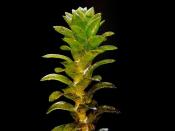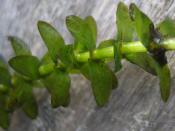Introduction:
The rate of photosynthesis varies greatly with changes in wavelengths of light. Light's colour is determined by its wavelength of light, and thus it is possible to devise an experiment to determine which wavelengths of light are most productive for photosynthesis than others.
In this experiment I use a plant called Elodea (pond weed). Elodea is native to North America and it is also widely used as aquarium vegetation. The basic structure of these plants are whirls of leaves around a stem that form a chain of long segments connected to looks like pipe cleaners with usually a diameter of about half an inch or so, depending on the species of elodea plants. Silty sediments and water rich in nutrients favour the growth of American waterweed in nutrient-rich lakes. I use this plant because it will grow in a wide range of conditions, from very shallow to deep water, and in many sediment types.
It can even continue to grow unrooted, as floating fragments.
The purpose of this experiment is to see under what conditions the elodea plants grow and photosynthesize the best. To accomplish this, the plants were subjected t different light colours (Blue, Green, Red and purple). This test will allow us to see which wavelength (colour) will allow the most light the elodea plant needs to flourish. Besides the light factor I also decided to put a 100 watt lamp above each plant so I get a high light intensity to speed up the rate of photosynthesis.
Aim:
The purpose of this experiment is to find out under what wavelength (different colour of light) the elodea plants are able to grow and photosynthesise the best. This experiment was consisted of 4 different colours of light, Blue, Green, Red and Purple.
Hypothesis:
I predict that the plant...


